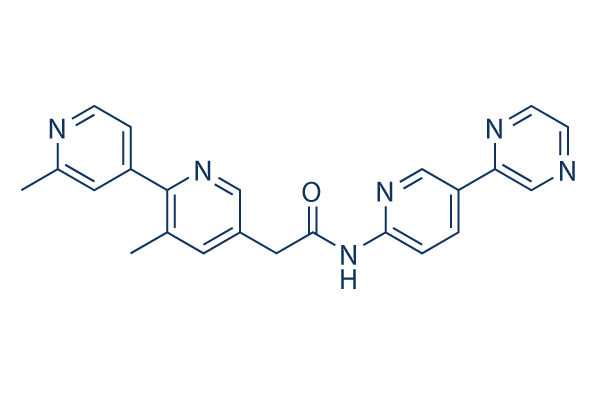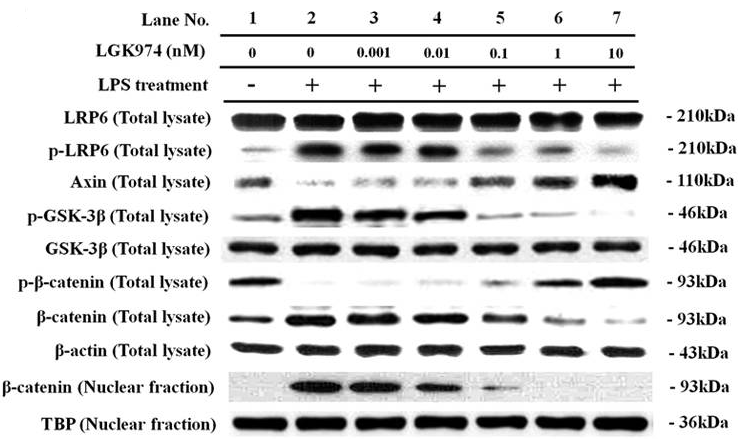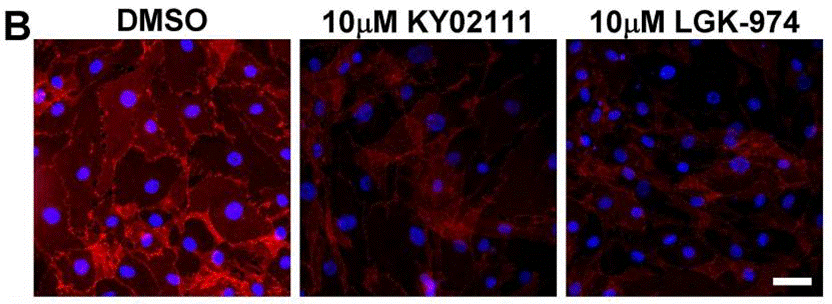
- Bioactive Compounds
- By Signaling Pathways
- PI3K/Akt/mTOR
- Epigenetics
- Methylation
- Immunology & Inflammation
- Protein Tyrosine Kinase
- Angiogenesis
- Apoptosis
- Autophagy
- ER stress & UPR
- JAK/STAT
- MAPK
- Cytoskeletal Signaling
- Cell Cycle
- TGF-beta/Smad
- DNA Damage/DNA Repair
- Compound Libraries
- Popular Compound Libraries
- Customize Library
- Clinical and FDA-approved Related
- Bioactive Compound Libraries
- Inhibitor Related
- Natural Product Related
- Metabolism Related
- Cell Death Related
- By Signaling Pathway
- By Disease
- Anti-infection and Antiviral Related
- Neuronal and Immunology Related
- Fragment and Covalent Related
- FDA-approved Drug Library
- FDA-approved & Passed Phase I Drug Library
- Preclinical/Clinical Compound Library
- Bioactive Compound Library-I
- Bioactive Compound Library-Ⅱ
- Kinase Inhibitor Library
- Express-Pick Library
- Natural Product Library
- Human Endogenous Metabolite Compound Library
- Alkaloid Compound LibraryNew
- Angiogenesis Related compound Library
- Anti-Aging Compound Library
- Anti-alzheimer Disease Compound Library
- Antibiotics compound Library
- Anti-cancer Compound Library
- Anti-cancer Compound Library-Ⅱ
- Anti-cancer Metabolism Compound Library
- Anti-Cardiovascular Disease Compound Library
- Anti-diabetic Compound Library
- Anti-infection Compound Library
- Antioxidant Compound Library
- Anti-parasitic Compound Library
- Antiviral Compound Library
- Apoptosis Compound Library
- Autophagy Compound Library
- Calcium Channel Blocker LibraryNew
- Cambridge Cancer Compound Library
- Carbohydrate Metabolism Compound LibraryNew
- Cell Cycle compound library
- CNS-Penetrant Compound Library
- Covalent Inhibitor Library
- Cytokine Inhibitor LibraryNew
- Cytoskeletal Signaling Pathway Compound Library
- DNA Damage/DNA Repair compound Library
- Drug-like Compound Library
- Endoplasmic Reticulum Stress Compound Library
- Epigenetics Compound Library
- Exosome Secretion Related Compound LibraryNew
- FDA-approved Anticancer Drug LibraryNew
- Ferroptosis Compound Library
- Flavonoid Compound Library
- Fragment Library
- Glutamine Metabolism Compound Library
- Glycolysis Compound Library
- GPCR Compound Library
- Gut Microbial Metabolite Library
- HIF-1 Signaling Pathway Compound Library
- Highly Selective Inhibitor Library
- Histone modification compound library
- HTS Library for Drug Discovery
- Human Hormone Related Compound LibraryNew
- Human Transcription Factor Compound LibraryNew
- Immunology/Inflammation Compound Library
- Inhibitor Library
- Ion Channel Ligand Library
- JAK/STAT compound library
- Lipid Metabolism Compound LibraryNew
- Macrocyclic Compound Library
- MAPK Inhibitor Library
- Medicine Food Homology Compound Library
- Metabolism Compound Library
- Methylation Compound Library
- Mouse Metabolite Compound LibraryNew
- Natural Organic Compound Library
- Neuronal Signaling Compound Library
- NF-κB Signaling Compound Library
- Nucleoside Analogue Library
- Obesity Compound Library
- Oxidative Stress Compound LibraryNew
- Plant Extract Library
- Phenotypic Screening Library
- PI3K/Akt Inhibitor Library
- Protease Inhibitor Library
- Protein-protein Interaction Inhibitor Library
- Pyroptosis Compound Library
- Small Molecule Immuno-Oncology Compound Library
- Mitochondria-Targeted Compound LibraryNew
- Stem Cell Differentiation Compound LibraryNew
- Stem Cell Signaling Compound Library
- Natural Phenol Compound LibraryNew
- Natural Terpenoid Compound LibraryNew
- TGF-beta/Smad compound library
- Traditional Chinese Medicine Library
- Tyrosine Kinase Inhibitor Library
- Ubiquitination Compound Library
-
Cherry Picking
You can personalize your library with chemicals from within Selleck's inventory. Build the right library for your research endeavors by choosing from compounds in all of our available libraries.
Please contact us at info@selleckchem.com to customize your library.
You could select:
- Antibodies
- Bioreagents
- qPCR
- 2x SYBR Green qPCR Master Mix
- 2x SYBR Green qPCR Master Mix(Low ROX)
- 2x SYBR Green qPCR Master Mix(High ROX)
- Protein Assay
- Protein A/G Magnetic Beads for IP
- Anti-Flag magnetic beads
- Anti-Flag Affinity Gel
- Anti-Myc magnetic beads
- Anti-HA magnetic beads
- Poly DYKDDDDK Tag Peptide lyophilized powder
- Protease Inhibitor Cocktail
- Protease Inhibitor Cocktail (EDTA-Free, 100X in DMSO)
- Phosphatase Inhibitor Cocktail (2 Tubes, 100X)
- Cell Biology
- Cell Counting Kit-8 (CCK-8)
- Animal Experiment
- Mouse Direct PCR Kit (For Genotyping)
- New Products
- Contact Us
research use only
LGK974 (WNT974) PORCN inhibitor
LGK974 (WNT974) is a potent and specific PORCN inhibitor that suppresses Wnt signaling with an IC50 of 0.4 nM in TM3 cells. This compound is currently in Phase 1 clinical trials.

Chemical Structure
Molecular Weight: 396.44
Purity & Quality Control
Batch:
Purity:
99.98%
99.98
Products Often Used Together with LGK974 (WNT974)
When combined with GDC-0941, it exhibits a synergistic effect in MDA-MB-231 cells.
Combination use of this compound and AZD-8055 reduces tumorigenesis and the immunosuppressive effects of early-stage myeloid-derived suppressor cells (eMDSCs) in mice.
Related Products
| Related Products | Wnt-C59 (C59) IWP-L6 ETC-159 IWP-O1 | Click to Expand |
|---|---|---|
| Related Compound Libraries | Kinase Inhibitor Library FDA-approved Drug Library Stem Cell Signaling Compound Library GPCR Compound Library Stem Cell Differentiation Compound Library | Click to Expand |
Cell Culture and Working Concentration
| Cell Lines | Assay Type | Concentration | Incubation Time | Formulation | Activity Description | PMID |
|---|---|---|---|---|---|---|
| HPAF-II | Growth Inhibition Assay | 1 μM | DMSO | inhibits the growth of pancreatic cancer cell lines with RNF43mutation | 23847203 | |
| PaTu 8988S | Growth Inhibition Assay | 1 μM | DMSO | inhibits the growth of pancreatic cancer cell lines with RNF43mutation | 23847203 | |
| Capan-2 | Growth Inhibition Assay | 1 μM | DMSO | inhibits the growth of pancreatic cancer cell lines with RNF43 mutation | 23847203 | |
| HPAF-II | Growth Inhibition Assay | 1 μM | DMSO | inhibits the growth of pancreatic cancer cell lines with RNF43 mutation | 23847203 | |
| PaTu8988S | Growth Inhibition Assay | 1 μM | DMSO | inhibits the growth of pancreatic cancer cell lines with RNF43 mutation | 23847203 | |
| 293T | Function Assay | IC50 of 0.4 nM to inhibits Wnt signaling in the aforementioned Wnt coculture assay | 24277854 | |||
| 293T | Function Assay | IC50 of 1 nM to compete off [3H]-GNF-1331 in a dose-dependent manner | 24277854 | |||
| HT1080 | Function assay | Inhibition of porcupine activity (unknown origin) expressed in human HT1080 cells assessed as suppression of Wnt3A-mediated super top flash activity by STF luciferase assay, IC50 = 0.0004 μM. | 26522946 | |||
| L Wnt3A, HEK293 | Function assay | 48 hrs | Inhibition of Wnt signaling (unknown origin) expressed in mouse L Wnt3A cells co-cultured with HEK293 cells after 48 hrs by Super-top flash reporter gene assay, IC50 = 0.0009 μM. | 26647303 | ||
| L Wnt3A, HEK293 | Function assay | 48 hrs | Inhibition of porcupine in mouse L Wnt3A cells co-cultured with HEK293 cells after 48 hrs by Super-top flash reporter gene assay, IC50 = 0.0009 μM. | 27692509 | ||
| L Wnt3A, HEK293 | Function assay | 48 hrs | Inhibition of porcupine in mouse L Wnt3A cells co-cultured with HEK293 cells assessed as suppression of Wnt signaling after 48 hrs by Super-top flash reporter gene assay, IC50 = 0.0009 μM. | 29499483 | ||
| HEK293T | Function assay | 0.1 uM | 48 hrs | Inhibition of porcupine (unknown origin) in HEK293T cells transfected with pLibin-WNT3A plasmid assessed as reduction in Wnt3A secretion into cell culture medium at 0.1 uM after 48 hrs by Western blot technique | 26647303 | |
| HEK293T | Function assay | 0.1 uM | 48 hrs | Inhibition of porcupine in HEK293T cells transfected with pLibin-WNT3A plasmid assessed as reduction in Wnt3A secretion into cell culture medium at 0.1 uM after 48 hrs by Western blot method | 27692509 | |
| BT-12 | qHTS assay | qHTS of pediatric cancer cell lines to identify multiple opportunities for drug repurposing: Primary screen for BT-12 cells | 29435139 | |||
| NB1643 | qHTS assay | qHTS of pediatric cancer cell lines to identify multiple opportunities for drug repurposing: Primary screen for NB1643 cells | 29435139 | |||
| OHS-50 | qHTS assay | qHTS of pediatric cancer cell lines to identify multiple opportunities for drug repurposing: Primary screen for OHS-50 cells | 29435139 | |||
| SK-N-MC | qHTS assay | qHTS of pediatric cancer cell lines to identify multiple opportunities for drug repurposing: Primary screen for SK-N-MC cells | 29435139 | |||
| HEK293 | Function assay | 100 nM | 48 hrs | Inhibition of porcupine in HEK293 cells transfected with pLibin-WNT3A plasmid assessed as downregulation of LRP6 phosphorylation at 100 nM after 48 hrs by Western blot analysis | 29499483 | |
| HEK293T | Function assay | 100 nM | 48 hrs | Inhibition of porcupine in HEK293T cells transfected with pLibin-WNT3A plasmid assessed as reduction in Wnt3A secretion into cell culture medium at 100 nM after 48 hrs by Western blot method | 29499483 | |
| PA1 | Function assay | 24 hrs | Inhibition of porcupine-mediated Wnt/beta-catenin signaling in human PA1 cells assessed as downregulation of Axin2 mRNA expression after 24 hrs by real-time PCR analysis | 29499483 | ||
| HEK293 | Function assay | 100 nM | 48 hrs | Inhibition of porcupine in HEK293 cells transfected with pLibin-WNT3A plasmid assessed as downregulation of disheveled 2 phosphorylation at 100 nM after 48 hrs by Western blot analysis | 29499483 | |
| Click to View More Cell Line Experimental Data | ||||||
Mechanism of Action
| Features | Orally bioavailable Porcupine-specific inhibitor that has been tested in Phase I clinical trials for treatment of malignancies dependent on Wnt ligands. | |
|---|---|---|
| Targets |
|
In vitro |
||||
| In vitro | In the PORCN radioligand binding assay, LGK974 (WNT974) effectively displaces [3H]-GNF-1331 with IC50 of 1 nM, and shows no major cytotoxicity in cells up to 20 µM. It shows comparable inhibitory activities against all tested Wnts with IC50 ranging from 0.05 to 2.4 nM, which is consistent with the genetic loss of PORCN phenotype. [1] This compound specifically inhibits the growth of three RNF43-mutant cell lines, HPAF-II, PaTu 8988S, and Capan-2. [2] | |||
|---|---|---|---|---|
| Cell Research | Cell lines | HPAF-II, PaTu 8988S, and Capan-2 cells | ||
| Concentrations | ~1 μM | |||
| Incubation Time | 3 days | |||
| Method | Cells are plated in growth medium in a 96-well plate at a density of 6,000–12,000 cells per well and treated with DMSO or 1 μM of this compound (LGK974, also known as WNT974). After 3 d, the cells are treated with fresh growth medium containing 20 μM EdU, which is included in the Click-iT EdU Alexa Fluor 488 HCS assay kit, and the plate was incubated for 2 h at 37 °C in a humidified atmosphere containing 5% CO2. Cells are fixed with final 4% (mass/vol) paraformaldehyde for 30 min, washed with PBS, permeabilized, and stained with 50 μg/mL Hoechst in PBS for 30 min. After wash, the cells are proceeded to EdU detection according to the instruction of Click-iT EdU assay kit. Triplet wells are performed for each condition. |
|||
| Experimental Result Images | Methods | Biomarkers | Images | PMID |
| Western blot | p-LRP6 / Axin / p-GSK3β / p-β-catenin / β-catenin NF-κB / IκB / p-IκB Nrf2 / Wnt3A / HO-1 / NQO-1 / Survivin |

|
28128299 | |
| Immunofluorescence | beta-catenin FUT8 α1, 6-fucosylation |

|
25639201 | |
In Vivo |
||
| In vivo | In a murine MMTV-Wnt1 tumor model and a human head and neck squamous cell carcinoma model (HN30), LGK974 (WNT974) (3 mg/kg) inhibits Wnt signaling in vivo and induces tumor regression without significant body weight loss in the mice. [1] This compound (5 mg/kg, p.o., BID) also inhibits tumor growth of RNF43-mutant pancreatic tumors (HPAF-II and Capan-2) in vivo. [2] | |
|---|---|---|
| Animal Research | Animal Models | A murine MMTV-Wnt1 tumor model and a human head and neck squamous cell carcinoma model (HN30) |
| Dosages | ~3 mg/kg daily | |
| Administration | Oral gavage | |
| NCT Number | Recruitment | Conditions | Sponsor/Collaborators | Start Date | Phases |
|---|---|---|---|---|---|
| NCT01351103 | Active not recruiting | Pancreatic Cancer|BRAF Mutant Colorectal Cancer|Melanoma|Triple Negative Breast Cancer|Head and Neck Squamous Cell Cancer|Cervical Squamous Cell Cancer|Esophageal Squamous Cell Cancer|Lung Squamous Cell Cancer |
Novartis Pharmaceuticals|Novartis |
December 1 2011 | Phase 1 |
References |
|
Chemical Information
| Molecular Weight | 396.44 | Formula | C23H20N6O |
| CAS No. | 1243244-14-5 | SDF | Download SDF |
| Synonyms | NVP-LGK974, WNT974 | ||
| Smiles | CC1=CC(=CN=C1C2=CC(=NC=C2)C)CC(=O)NC3=NC=C(C=C3)C4=NC=CN=C4 | ||
Storage and Stability
| Storage (From the date of receipt) | |||
|
In vitro |
DMSO : 79 mg/mL ( (199.27 mM) Moisture-absorbing DMSO reduces solubility. Please use fresh DMSO.) Water : Insoluble Ethanol : Insoluble |
Molecular Weight Calculator |
|
In vivo Add solvents to the product individually and in order. |
In vivo Formulation Calculator |
|||||
Preparing Stock Solutions
Molarity Calculator
In vivo Formulation Calculator (Clear solution)
Step 1: Enter information below (Recommended: An additional animal making an allowance for loss during the experiment)
mg/kg
g
μL
Step 2: Enter the in vivo formulation (This is only the calculator, not formulation. Please contact us first if there is no in vivo formulation at the solubility Section.)
% DMSO
%
% Tween 80
% ddH2O
%DMSO
%
Calculation results:
Working concentration: mg/ml;
Method for preparing DMSO master liquid: mg drug pre-dissolved in μL DMSO ( Master liquid concentration mg/mL, Please contact us first if the concentration exceeds the DMSO solubility of the batch of drug. )
Method for preparing in vivo formulation: Take μL DMSO master liquid, next addμL PEG300, mix and clarify, next addμL Tween 80, mix and clarify, next add μL ddH2O, mix and clarify.
Method for preparing in vivo formulation: Take μL DMSO master liquid, next add μL Corn oil, mix and clarify.
Note: 1. Please make sure the liquid is clear before adding the next solvent.
2. Be sure to add the solvent(s) in order. You must ensure that the solution obtained, in the previous addition, is a clear solution before proceeding to add the next solvent. Physical methods such
as vortex, ultrasound or hot water bath can be used to aid dissolving.
Tech Support
Answers to questions you may have can be found in the inhibitor handling instructions. Topics include how to prepare stock solutions, how to store inhibitors, and issues that need special attention for cell-based assays and animal experiments.
Tel: +1-832-582-8158 Ext:3
If you have any other enquiries, please leave a message.
* Indicates a Required Field
Frequently Asked Questions
Question 1:
If LGK974 is a lipophilic or hydrophilic substance?
Answer:
LGK974 is a lipophilic compound.





































